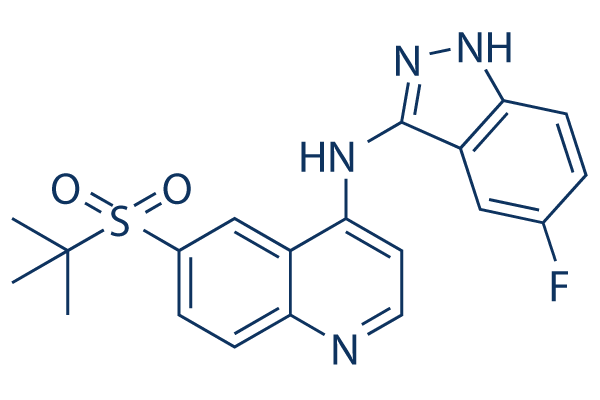All AbMole products are for research use only, cannot be used for human consumption.

In vitro: GSK583 possesses comparable binding affinity for RIP3 kinase as demonstrated by an in-house FP binding assay configured similarly to the RIP2 FP assay (RIP2 FP IC50 = 5 nM; RIP3 FP IC50 = 16 nM). Despite this potent biochemical activity against RIP3 kinase, GSK583 shows little or no inhibition of RIP3-dependent necroptotic cell death in a cellular assay up to 10 μM concentration. GSK583 potently and dose dependently inhibits MDP-stimulated tumor necrosis factor-alpha (TNFα) production with an IC50 = 8 nM in primary human monocytes. Following treatment with GSK583 at 1 μM, little inhibition of pro-inflammatory signaling is observed upon activation of Toll-like receptors (TLR2, TLR4, TLR7) or cytokine receptors (IL-1R, TNFR) but complete inhibition is observed upon activation of both NOD1 and NOD2 receptors, which signal in a RIP2-dependent manner. Although GSK583 has excellent kinase selectivity, it does inhibit both the hERG channel and Cyp3A4, which precludes it from further progression as a drug candidate. In vivo: GSK583 has low clearance, moderate volumes of distribution, and moderate oral bioavailability in both rat and mouse. Eventhough GSK583 would not produce a human phamacodynamic response within an acceptable dose range which precludes this molecule from further development as a drug candidate, the oral PK in rat and mouse provides sufficient systemic exposure for use as a preclinical in vivo tool molecule in an acute inflammation challenge mode.
| Cell Experiment | |
|---|---|
| Cell lines | primary human monocytes |
| Preparation method | To assess cellular selectivity, monocytes are pretreated with inhibitor for 30 min, then stimulated for 6 h with ligands which selectively agonize NLRs NOD1, NOD2; Toll-like receptors TLR, TLR4, TLR7, or cytokine receptors IL-1R, TNFR. Release of pro-inflammatory cytokines, either TNFα (NOD2, TLR2, TLR4, IL1R) or IL-8 (NOD1, TLR7, TNFR), is measured by immunoassay. Percent inhibition and/or IC50 values are calculated. |
| Concentrations | 1 μM |
| Incubation time | 30 min |
| Animal Experiment | |
|---|---|
| Animal models | C57BL/6 mice |
| Formulation | |
| Dosages | 0.1, 1, 10 and 100 mg/kg |
| Administration | oral administration |
| Molecular Weight | 398.45 |
| Formula | C20H19FN4O2S |
| CAS Number | 1346547-00-9 |
| Solubility (25°C) | DMSO 80 mg/mL |
| Storage |
Powder -20°C 3 years ; 4°C 2 years In solvent -80°C 6 months ; -20°C 1 month |
| Related RIPK Products |
|---|
| RIP1/RIP3/MLKL activator 1
RIP1/RIP3/MLKL activator 1 is a potent, blood-brain barrier permeable anti-glioma agent. RIP1/RIP3/MLKL activator 1 induces necroptosis through RIP1/RIP3/MLKL pathway. |
| Oditrasertib
Oditrasertib is a receptor-interacting protein kinase 1 (RIPK1) inhibitor with an IC50 value lower than 100 nM. |
| OD36 hydrochloride
OD36hydrochloride is a RIPK2 inhibitor with an IC50 of 5.3 nM. |
| RIPK1-IN-12
RIPK1-IN-12 is a potent RIPK1 inhibitor. |
| DNL747
DNL747 is an ASK1 and RIPK1 inhibitor for studies related to Alzheimer's disease, amyotrophic lateral sclerosis, and multiple sclerosis. |
All AbMole products are for research use only, cannot be used for human consumption or veterinary use. We do not provide products or services to individuals. Please comply with the intended use and do not use AbMole products for any other purpose.


Products are for research use only. Not for human use. We do not sell to patients.
© Copyright 2010-2024 AbMole BioScience. All Rights Reserved.
